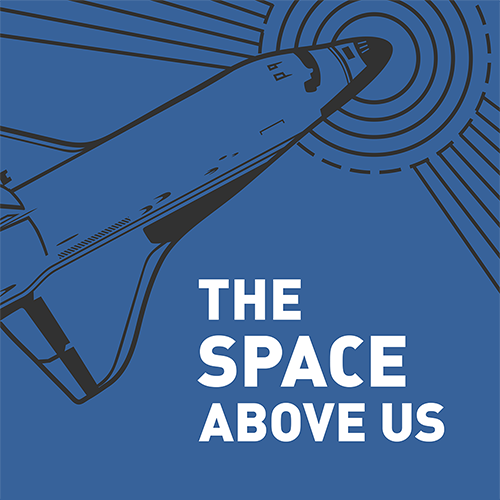Episode 184: STS-103 - Y2K And I Feel Fine (Hubble Servicing 3A)
Table of Contents
The Hubble Space Telescope couldn’t wait until the year 2000 for a visit, while the Space Shuttle’s computers couldn’t handle the year 2000 at all. With the clock ticking, will the crew of STS-103 be able to save the new year for scientists everywhere?
Episode Audio #
Photos #
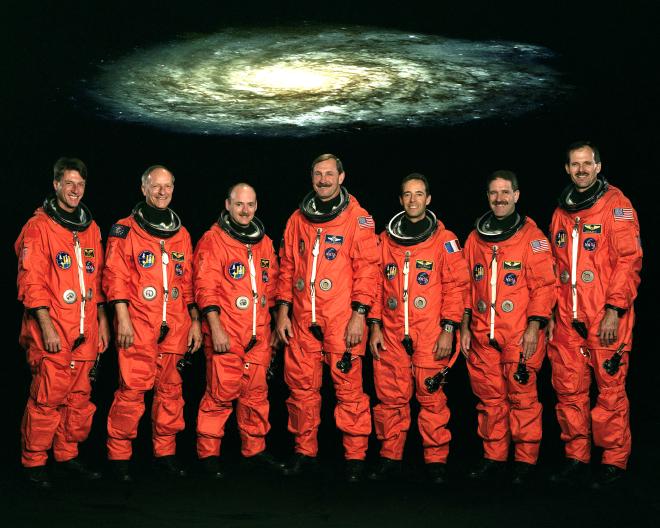
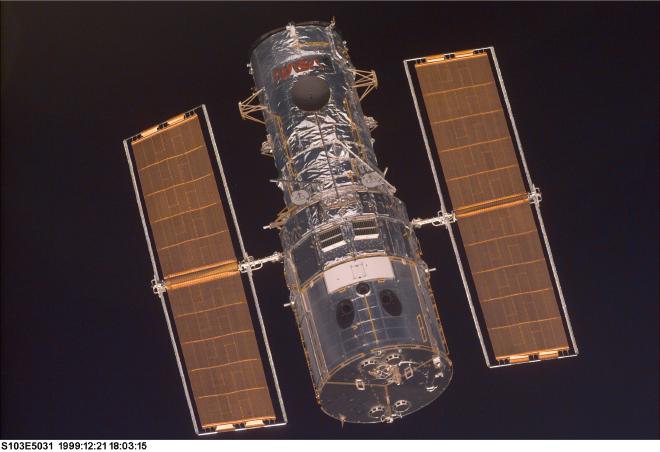
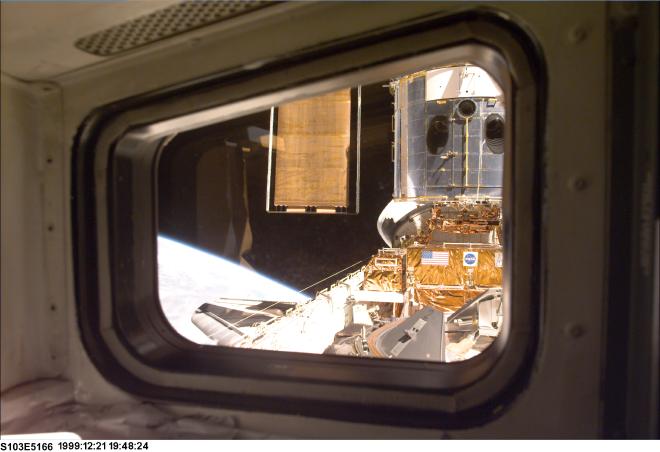
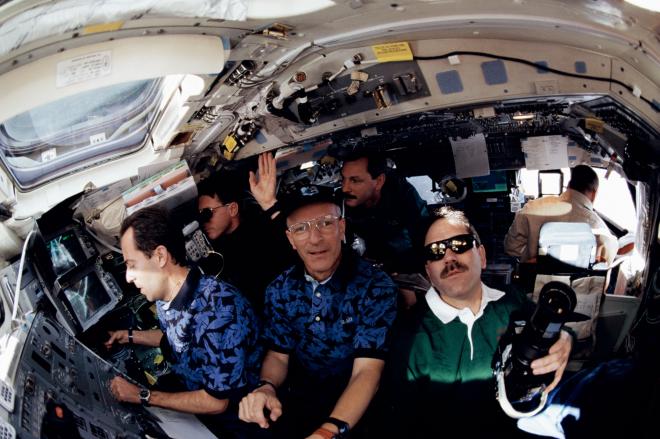
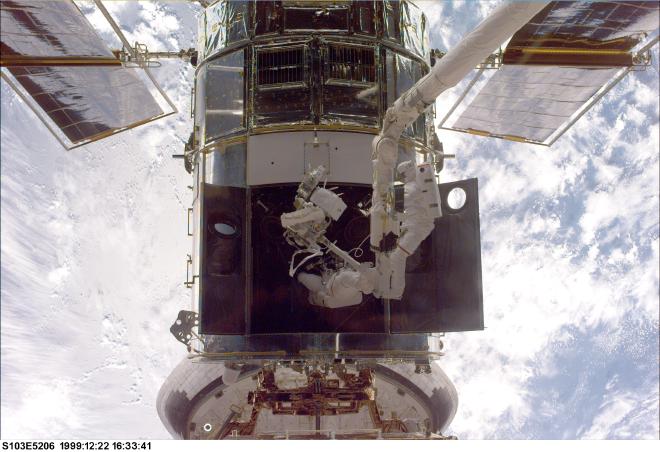
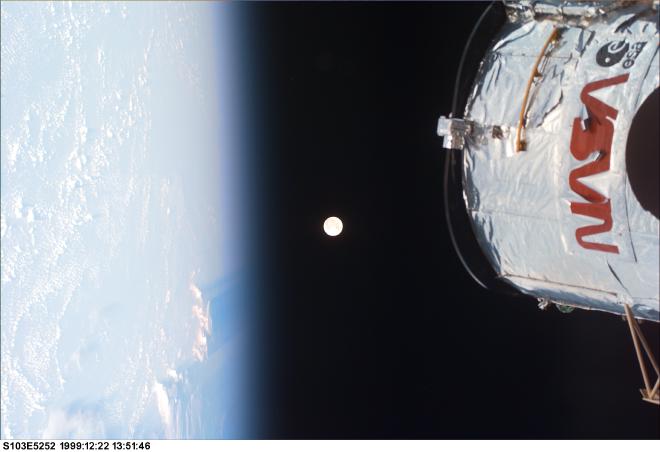
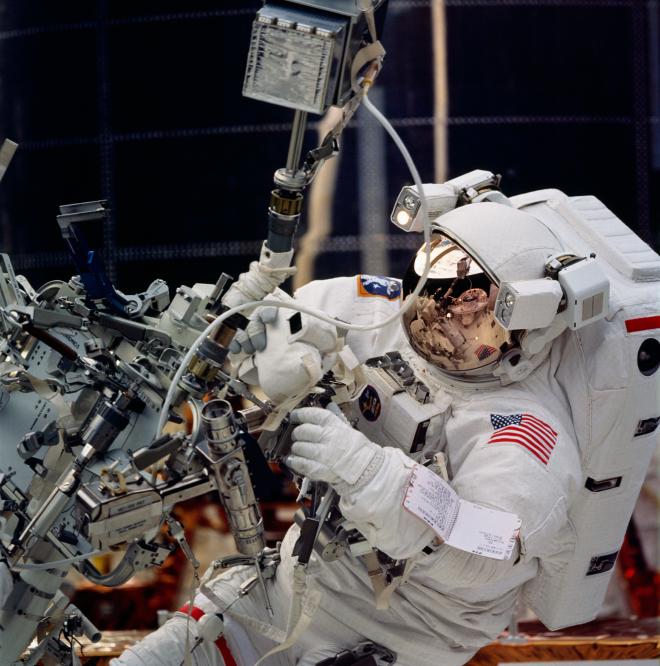
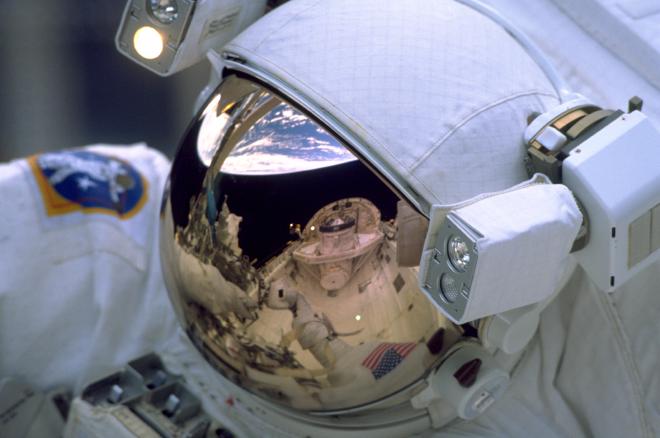
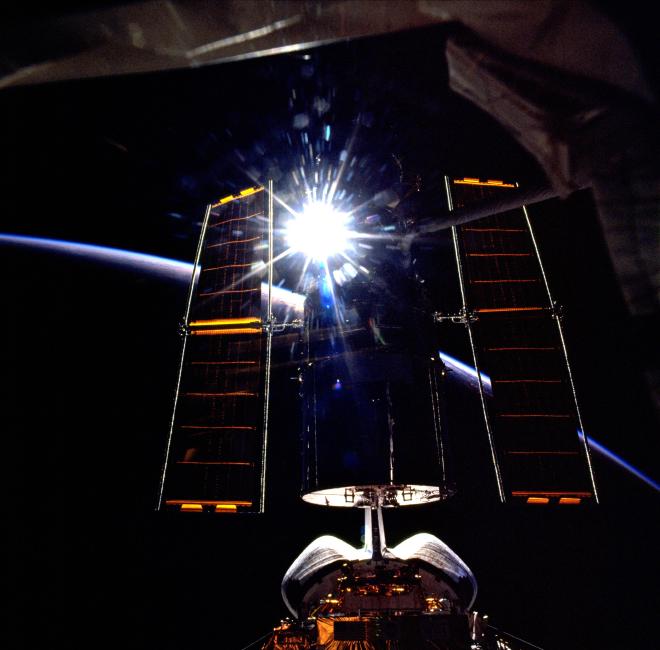
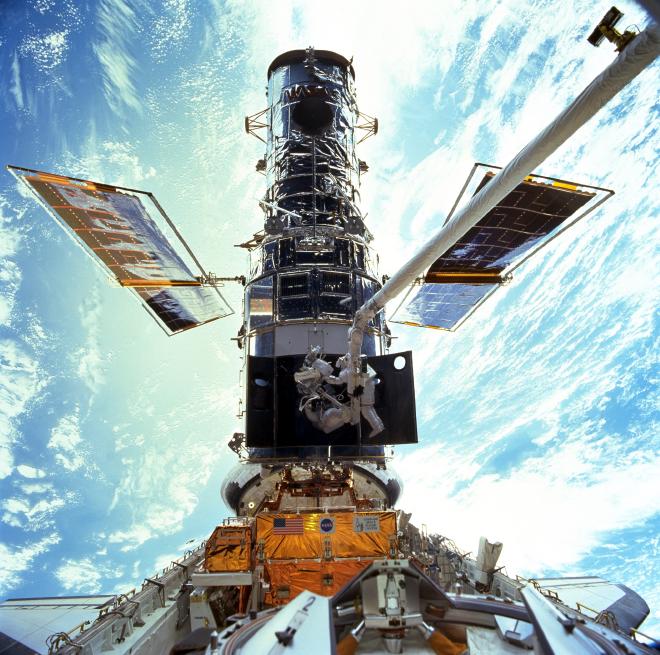
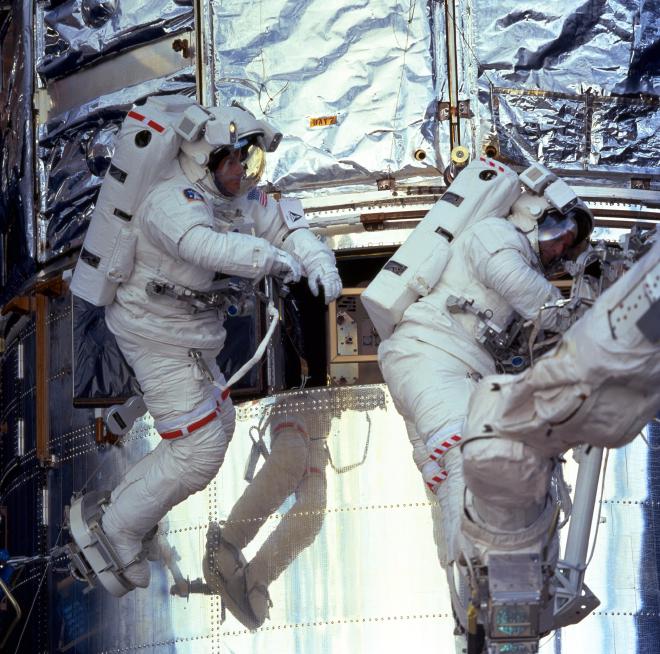
For more photos, head over to our friends at Wikiarchives.space: https://wikiarchives.space/index.php?/category/612
Post-Flight Presentation #
Space Shuttle Stories #
If you haven’t already picked up a copy of Tom Jones’ book “Space Shuttle Stories” you can find it over at Penguin Random House and in bookstores everywhere!
Transcript #
NOTE: This transcript was made by me just copying and pasting the script that I read to make the podcast. I often tweak the phrasing on the fly and then forget to update the script, so this is not guaranteed to align perfectly with the episode audio, but it should be pretty close. Also, since these are really only intended to be read by myself, I might use some funky punctuation to help remind myself how I want a sentence to flow, so don’t look to these as a grammar reference. If you notice any egregious transcription errors or notes to myself that I neglected to remove, feel free to let me know and I’ll fix it.
Hello, and welcome to The Space Above Us. Episode 184, Space Shuttle flight 96, STS-103: Y2K And I Feel Fine
Last time, we talked about the 26th flight of Space Shuttle Columbia, STS-93. This flight is fascinating for a number of different reasons. Of course, Eileen Collins made history by becoming the first woman to command a United States spaceflight mission. Columbia also deployed the Chandra X-Ray Observatory, one of the four Great Observatories, giving scientists a whole new way to look at the universe. But for someone like me, who loves a good detailed incident breakdown, the flight is perhaps best known for the two unrelated main engine problems that nearly resulted in an aborted mission, maybe even with the dreaded Return To Launch Site abort. In the end, Columbia, its crew, and NASA’s human spaceflight program dodged a golden bullet, and the mission was a complete success, despite the collective raised blood pressure of mission control.
Today, we’ll again be discussing one of the Great Observatories, but one we’re already pretty familiar with: the Hubble Space Telescope. Hubble had always been designed with servicing in mind, which came in handy when a certain piece of equipment was 1.3 millimeters out of alignment and the telescope arrived on orbit with a slightly misshapen mirror. But while most people know about that dramatic first servicing mission, it wasn’t the only servicing mission. We returned on STS-82, tending to both the infrastructure of the telescope itself, as well as taking advantage of the presence of skilled human hands and swapping out some of the scientific instruments. Thanks to Hubble’s unique situation, it was possible to develop improved versions of instruments already on orbit, or entirely new ones to answer new questions, and breathe new life into the telescope.
And that was exactly the plan for STS-103, initially slated for June of 2000. It was planned as an ambitious six EVA mission that, just like the previous Hubble servicing mission, would upgrade its scientific capabilities while also replacing worn or obsolete components of the telescope’s support structure such as sensors, antennas, and computers. This plan changed, however, when Hubble decided that it didn’t want to wait until 2000 for a visit after all.
In order to explain what what I’m getting at, we need to take a quick look at how the Hubble Space Telescope orients itself in space. Obviously, in order to observe a distant galaxy or exploding star or voracious black hole or whatever, the Hubble must first point its mirror at it in order to collect its light. But how does it actually physically do this? Using the jargon of aerospace engineering, how does Hubble’s attitude control work? When the Space Shuttle Orbiter wants to change its attitude, it uses dozens of small rocket thrusters positioned all around the vehicle, pushing it around. This a good solution for the Shuttle, which needs to have responsive attitude control, as well as a lot of attitude control authority for situations like reentry. Basically, it needs a lot of oomph, and thrusters are a good way to get oomph.
But using thrusters for attitude control comes with a number of downsides. For one thing, I rarely mention it anymore, but on just about every Shuttle mission, at least one thruster gets “deselected” by the computer after exhibiting some wonky behavior. This essentially labels the thruster as broken, and it’s just not used until folks on the ground can take a look at what was making it act weird. So, thrusters break. Thrusters are also suitable for the Shuttle because the Orbiter is only typically in space for a week or two, meaning its thruster propellant doesn’t need to last all that long. Thrusters need propellant, and propellant is heavy and finite.
For something like Hubble, which needs to run indefinitely, these issues become much bigger, but there’s an even bigger problem with an observatory like Hubble using thrusters: contamination. People have a pretty natural tendency to think of space as being empty and infinite. I don’t blame them, that’s sure what it seems like. But as we’ve learned, when you’re doing things that require extreme precision, human intuition tends to break down. Every time the Shuttle fires its thrusters, it doesn’t just magically push the Shuttle around. In order to push the big heavy Shuttle slowly in one direction, the thruster pushes a small amount of burned-up propellant very fast in the other direction. So surrounding the Shuttle is a sort of thin haze of spent propellant, along with products from outgassing of the Orbiter, and even stuff like dumping excess water overboard. For the Shuttle, this is no big deal. But for the Hubble, it doesn’t want to constantly be squinting through a cloud of its own exhaust, or worse, get it on the mirror. So thrusters are out.
OK then, so how does it point where it wants? Ah well, anyone who was paying attention during the Skylab and Mir episodes can tell you that: by exploiting the conservation of angular momentum. That is, gyroscopes! Forgive me for bringing up an example I know I have mentioned in the past, and which is in every physics textbook and documentary ever, but I’m going to do it anyway. If you were so sit in a swivel chair while holding a spinning bicycle wheel along its axis, and then turn that axis, you’ll feel the wheel resisting that motion and you’ll start to rotate in the swivel chair. I’m not going to get into all the physics of this here, but essentially, a spinning thing doesn’t want to turn. It also doesn’t want to speed up or slow down. And by exploiting that, sticking a bunch of spinning things onto a vehicle and trying to turn them, it’s possible to rotate that vehicle. And if you’re good at matrix math and aren’t scared of the word “quaternion”, you can point that vehicle with remarkable precision, all by carefully controlling the rotation of the spinning things.
So Skylab, Mir, and a lot of uncrewed satellites basically have a set of really high quality and really fancy bicycle wheels called reaction control wheels, and they’re arranged in different orientations. By speeding up or slowing down their spinning, it’s possible to rotate the vehicle. It’s not as zippy as using thrusters, but it doesn’t use a finite onboard resource like propellant and it doesn’t make a mess by spraying stuff overboard. Hubble has four of these reaction wheel assemblies.
Now, I’m sure you’re expecting this to all have been a buildup to saying that Hubble’s reaction wheel assemblies were dying, but actually no. The reaction wheels are only half the equation. They’re the actuators, the part that makes the desired motion happen. Also needed are rate sensors that measure the motion, and it was these sensors that were the problem. The four wheels could change Hubble’s orientation, but without a way to track that rotation, they would be pointing blind. Hubble had a few ways of tracking that motion. There’s really coarse stuff like sensing the telescope’s orientation with respect to the Earth’s magnetic field, or special sensors that could detect which general direction the sun was. There are also extremely fine grained sensors called, appropriately enough, Fine Guidance Sensors. But in between those extremes are three Rate Sensor Units, each containing two gyroscopes. These days, engineers have figured out a way to get by on only a single gyroscope but back in 1999, three were required in order to maintain pointing authority.
Astronauts last visited Hubble on STS-82, in February of 1997, and when they left, all six gyros were working. But one failed later that year, another failed in 1998, and a third failed earlier in 1999. If a fourth gyroscope failed, the telescope would not be in danger, but there would be no choice but to put it in a safe mode that kept its delicate instruments pointed away from the sun while keeping its solar panels pointed at the sun. Safe mode would keep the telescope alive, but would allow no science to be performed. And that squandered precious resources in two ways, depending on how you want to look at it. First, it cost around 20 million dollars a month to maintain the ground infrastructure and expertise necessary to operate the telescope, whether or not it was doing anything useful. And second, as project scientist David Leckrone noted, every month Hubble wasn’t doing science was a month lost to science forever.
Since NASA really really didn’t want Hubble potentially sitting around in safe mode for months, the decision was made to move STS-103’s launch up from June of 2000 to October of 1999. Hubble needed help. So let’s meet the crew who was going to help it.
Commanding this mission is a familiar face, Curt Brown. Brown’s face is so familiar because he is one of only three people who served as Space Shuttle commanders to have flown in space six times. If you want to guess the other two you’ve got until the end of this needlessly long and rambling sentence that goes on and on to pause the podcast, last chance ok that’s as long as I can stall: the other two were Jim Wetherbee, and our not so secret favorite, John Young. We last saw Brown commanding STS-95, which flew a number of complex science experiments in SPACEHAB as well as giving a nice old senior citizen a ride from Florida to.. well.. Florida. This is Brown’s sixth and final flight.
Joining Brown up front is today’s pilot and lone rookie for this mission, Scott Kelly. Scott Kelly was born on February 21st, 1964 in Orange, New Jersey, six minutes earlier than his identical twin brother and fellow astronaut Mark Kelly. I’m sure Scott will insist he’s the good looking one of the identical twins. Kelly earned a Bachelor’s degree in Electrical Engineering from the State University of New York Maritime College, and later earned a Master’s in Aviation Systems from the University of Tennessee in Knoxville. In between those two degrees, Kelly became a naval aviator and learned how to fly the F-14 Tomcat. After some overseas deployments on aircraft carriers, Kelly graduated from the Naval Test Pilot School, going on to work as a test pilot at the Naval Air Warfare Center in Patuxent, Maryland, flying the F-14 Tomcat and F/A-18 Hornet. He was selected as an astronaut in 1996 and is an interesting new breed of astronaut: Shuttle pilots who would go on to become Space Station commanders. I should have made this point earlier with Frank Culbertson and Ken Bowersox, but Culbertson, Bowersox, Kelly, and others will have astronaut careers that blend the lines between pilot crew and mission specialist. Kelly will fly the shuttle again, that time as Commander, but will then move to the Space Station side of things, commanding two lengthy missions including the famous “year-long” twin study. And as part of those stints he’ll manage science experiments and perform EVAs, just like a mission specialist, activities that previously were not under the umbrella of Shuttle commander duties. But that’s all in the future. For now, this is Kelly’s first of four flights.
Once again throwing off the usual flow, to find Mission Specialist 1, John Grunsfeld, we’ll have to head down to the middeck. We’ve met Grunsfeld a couple of times now, most recently on STS-81, which delivered Jerry Linenger to Mir while retrieving John Blaha. Grunsfeld is one of four spacewalkers on this mission, his third of five.
Mission Specialist 2, as Flight Engineer, always sits right behind the Commander and Pilot, so it’s back up to the flight deck we go, where we find Jean-Francois Clervoy. The last time we saw Clervoy he was picking up where Grunsfeld left off, helping to bring Jerry Linenger home while delivering Mike Foale to Mir. For today’s mission he’ll be primarily focused on operating the robot arm during the servicing EVAs, a role that I think is often underappreciated. It’s not easy to focus that hard on coordinating the movements of two spacewalkers while also carefully manipulating a fifty foot long robot arm for hour after hour. But Clervoy is up to the challenge on this, his third and final flight.
Mission Specialist 3, seated alongside Clervoy on the flight deck, was present both when Mike Foale was delivered to Mir and when he came home. He was even there when Mike Foale was on Mir.. because he’s Mike Foale! Making his first flight since returning from the Russian Space Station, Foale will be making his second EVA, but his first from an American vehicle. This is his fifth of six flights.
Moving back downstairs, we find Mission Specialist 4, and Payload Commander for today’s flight, Steve Smith. Smith was an expert on working with the Hubble, since he’s the only one of the crew who’s actually done it before, flying as part of STS-82, the second Hubble servicing mission, on his previous flight. Smith had the overall responsibility for the EVAs on this mission, so I’m sure he didn’t mind the lack of visual distractions down on the middeck for the ride uphill. This is his third of four flights.
Finally, we come to Mission Specialist 5, Claude Nicollier. Nicollier has been around for a while now, most recently flying on the second Tethered Satellite System mission which, well, did not turn out as hoped. But that was no fault of Nicollier’s, so today he was looking forward to his next challenge: becoming the first European Space Agency astronaut to perform a spacewalk from an American vehicle. This is his fourth and final flight.
It turned out it was a good idea to drag this mission to the left on the calendar, because on November 13th, 1999, with Space Shuttle Discovery already on the launchpad, the dreaded scenario came true: a fourth gyroscope failed, and ground control at the Goddard Space Flight Center had no choice but to place Hubble into safe mode. The telescope would now orient its solar arrays to the Sun to ensure a reliable source of power, and place itself in a slow spin stabilization roll, much to the delight of a certain corner of this podcast’s listenership. With Hubble safe but no longer gathering science data, the clock was now really ticking.
The STS-103 crew had nearly swooped in in the nick of time though. The original launch date had been October 14th, but that had been pushed back and pushed back thanks most of all to the extra wiring inspections required after the drama of STS-93. Though there was also an incident where a tiny piece of a drill bit broke off inside one of the main engines, requiring ground crews to swap out the whole engine. Whoops.
As the launch continued to experience a frustrating series of delays, a problem began to loom more and more large on the horizon. A problem that most people roll their eyes at these days, but that was very serious then and despite its reputation should still garner respect today: Y2K.
Yes, that Y2K. For those too young to remember, first of all, get off my lawn. Secondly, Y2K is the shorthand name for a problem that people realized would crop up at midnight on January 1st, 2000. “Year 2000”, hence “Y2K”. Basically, computers would go back in time. I’ll explain. Over the years, millions and millions of lines of computer code related to time and dates had been written. And through a combination of wanting to save memory on early spartan computer systems and laziness on the part of programmers, the year was often represented with only two digits. After all, in the year 1982 or whatever, the year 2000 was forever away, and surely this code will be replaced by then, right? Well, not always. So there was a lot of computer code that thought ‘98’ meant 1998, and ‘99’ meant 1999, and that ‘00’ meant… 1900. This could cause annoying issues on personal computers, but for computers that governed banking, stock markets, airplanes, navigation systems, and yes, Space Shuttles, the consequences could be much more dire. Just as one example off the top of my head, let’s say your navigation software was doing some math to figure out the position of the Earth, and thus the Orbiter’s position around it, based on the current time and date. If the time and date suddenly lurched backwards 100 years, who knows what that geometry would be now. Best case, your guidance system will throw its hands up in confusion and give up, shutting down. Worst case, it just keeps trying but with very wrong ideas.
People tend to laugh at Y2K now, viewing it some sort of wildly overblown overreaction to a non-problem. I think part of that is that people took the reasonable concerns of software engineers, listened to only the worst case scenarios, inflated those worst case scenarios in their heads (likely with the news cycle gleefully egging it on to get more eyes on them), and created this idea that when the clock struck midnight you’d have airplanes falling out of the sky, nuclear bombs going off, cats and dogs living together, mass hysteria. Then when the clock did strike midnight.. pretty much nothing happened. An annoyingly large number of people took this as evidence that nothing was wrong in the first place. But Y2K really was a serious problem! And the reason that nothing happened was because experts saw it was going to be a problem and decision makers dedicated vast resources to fixing it before it could become a problem. It’s like people who say measles vaccines aren’t necessary anymore because nobody gets measles these days. Or that money spent reinforcing a building before an earthquake was a waste because when the earthquake hit.. the building was fine. People seem incapable of understanding that a crisis averted was still a crisis. But I suppose I am digressing.
Despite extensive ground testing that said the Orbiter’s software should handle the new year in stride, there was a strong desire to ensure that Space Shuttle Discovery and its crew were safely back on the ground, with all the Orbiter’s computers shut down, before the year 2000 rolled over, lest its computers get confused and lead to some sort of computer crash, which could lead to, y’know, an actual crash.
At the same time, Hubble scientists were losing their minds that Discovery was still on the ground while their poor telescope was just sitting around, burning science days. So rather than delay past the new year, mission planners compressed the flight, lopping days, and a spacewalk, off the end. This would guarantee that even if there were a few days of landing delays, there would be time to shut down Discovery’s computers before the new years, and the crew would be home to party like it’s 1999.
So it was that on the last possible day, with the mission already somewhat truncated, Discovery and the STS-103 crew found themselves on the launchpad when the countdown hit zero, and on December 19th, 1999, at 7:50 pm Eastern Standard Time, Space Shuttle Discovery lifted off for the 27th time, becoming the only launch-on-need flight of the entire program.
Rendezvous proceeded smoothly, with Brown and Kelly swapping back and forth when executing far field maneuvers. One difference that might be easy to miss, but that caught my flight dynamics eye, was the fact that this was the first Hubble rendezvous to use the ORBT approach. ORBT, again, is the somewhat maddening acronym for “Optimized R-bar Target Rendezvous”. Essentially, when performing the last big maneuver, kicking off the terminal phase of the rendezvous, Discovery would aim to pass a little underneath Hubble, instead of the old approach which would have had it bob right up to the telescope itself. Since the actual goal was to arrive on the R-bar, the line between the Hubble and the Earth, and work their way up, it made more sense to aim for the R-bar entry point in the first place. This tweak saved a little bit of propellant, which is always in high demand on prox ops missions.
This could have especially been the case on this flight since Hubble was in safe mode, meaning the ground lacked the ability to direct the observatory to a convenient attitude for capture. Hubble’s simple directive of keeping itself alive allowed for some freedom of its orientation, and there was nothing guaranteeing that the grapple fixture would be within easy reach when Discovery moved up from below. But luck was on the crew’s side that day and Clervoy was able to snag Hubble with no difficulty just under 48 hours into the flight.
Before we get started on the EVAs I have to confess that I left a pretty major detail out earlier. When I introduced STS-103 I mentioned how it planned on performing a record breaking six EVAs as it upgraded the telescope and its scientific instruments. Then I mentioned that due to Y2K concerns, the last EVA had been cut from the mission. So that should bring us down to five, right? No, we’re actually down to three. The problem was that STS-103 was forced to scramble and launch six months early, due to the failing rate sensor units. Having the flexibility to go up early and get Hubble back in working order was great, but the teams that were working on the upgrades to the science instruments had been expecting a flight in June of 2000 and the upgrades simply weren’t ready yet.
The result was that Hubble Servicing Mission 3 was split into two flights, with STS-103 becoming 3A and the upcoming STS-109 becoming 3B. 3A would focus entirely on the health and safety of the telescope itself, leaving all the science upgrades to 3B down the road. I’m sure this was a letdown to the crew, especially for the folks who were heading outside, but as always they seemed to take it in stride. I think astronauts, especially ones who have been around for a while, know that there is a world of difference between a flight assignment and the flight that actually happens. You just have to be happy with what you get. And let’s not feel too bad for them. Half of a Hubble servicing mission is still pretty incredible.
So, here we are, with Hubble safely berthed in the payload bay, and the crew ready to go fix its stricken rate sensor units, restoring the observatory to working order. But if Steve Smith and John Grunsfeld don’t mind hanging out in the airlock for just another minute, there is a natural question to answer: what’s up with all these failing gyroscopes? NASA was pretty sure they knew the cause of the problem, but to explain it, we need to crack one of these things open and see how they work.
Each Rate Sensor Unit is a box that weighs a bit more than 10 kilograms and is somewhere in size between a home laser printer or a big shoe box. I mean, I could also say it’s 30 by 27 by 23 centimeters but I think “big shoe box” is more useful. Inside the box are two gyroscopes. Each gyroscope is a little wheel that spins at a kind of incredible 19,200 revolutions per minute. The gyroscope is enclosed in a cylinder which is allowed to float freely inside a thick fluid. The official sources compare this goop to 10W-30 motor oil but to my great shame I always let the guy at the car place change my oil so that didn’t really help me out. Instead, I ended up on the Wikipedia page with the delightful name “List of viscosities” which is where I learned that 10W-30 motor oil is on the lighter end of possible viscosities for honey. So let’s just go with “warm honey”.
So the gyroscope wheel is in the cylinder and the cylinder is floating in the honey, but we still need to power the gyroscope and get data from it. To do this, extremely thin wires, around the width of a human hair, are run through the honey-like fluid. They are extremely fragile and they are the source of the problem. It seems that when this entire unit is assembled, the folks making it would use pressurized air to hold the goop in place as they closed it up. The problem is that air has oxygen in it, which seems to have slowly caused an oxidation reaction in the fluid, which created just a little bit of debris floating around inside which could slowly wear away at these incredibly thin wires. No wires, no power or data. To prevent this from happening, the new units were assembled with pressurized nitrogen instead of pressurized air, so there would be no oxygen, and thus no oxidation, and thus no problem.
So let’s go swap them out! On Flight Day 4, Steve Smith and John Grunsfeld climbed out of the airlock. To tell them apart, Smith’s suit had a red stripe on the arms and legs, and Grunsfeld’s was solid white. After the lesson learned on STS-82, the airlock depressurization procedure had been updated, so there were no solar arrays flapping around from vented gas this time.
As usual, activities were sorted by order of priority in case an emergency required a quick departure, so Smith and Grunsfeld immediately got to work on replacing the rate sensor units. All three units would be swapped out just to be on the safe side. With the suspected cause of “debris in the weird goop” it made sense to just replace everything. And with the nice bit of anti-climax that you always hope for in a real mission, even if it doesn’t make a great story, the duo quickly swapped out the electronic boxes with no difficulty, and the item at the top of the priority list was complete.
The crew had come an awfully long way just to do that one repair, however, so after essentially changing the oil, they decided they may as well check the tire pressure, replace the windshield wipers, check their headlight fluid, and so on. Which is my dumb way of saying we’ve got more work to do. After replacing the Rate Sensor Units, Smith and Grunsfeld moved on to the Near Infrared Camera and Multi-Object Spectrometer, or NICMOS. This instrument had been installed on STS-82 and, being an infrared camera, it required extremely cold temperatures in order to operate efficiently. It had been launched with a supply of cryogenic coolant that was planned to last several years, but a piece of the structure had warped slightly, allowing two piece of metal to touch, which let heat into NICMOS faster than anticipated, causing it to burn through its entire coolant supply much faster than expected. The term I saw for this is a “thermal short” which is a cool idea. Just like an electrical short circuit is when electricity goes somewhere it wasn’t supposed to, closing the loop and causing mayhem, this metal contact caused the same sort of problem, but with heat.
NICMOS was going to be updated on Servicing Mission 3B, using a new and improved cooling unit, but for that to work, they first had to make sure that the current plumbing was completely empty. As such, the EV crew’s task was to open some valves and allow the trace amounts of remaining coolant to vent out into space until the next mission. The valve covers actually proved to be quite a challenge to open, creating a significant delay in the spacewalk, but eventually, through a little brute force, the task was complete.
Next was the installation of six Voltage Improvement Kits, or VIKs. These were little devices that dictated how the telescope’s batteries were charged. As the observatory aged, these batteries would start to wear out, requiring a little more gentle handling. These VIKs changed how the batteries were charged, making it less likely that they over-charged or over-heated, both of which could damage them and reduce their longevity. Something that kind of made me laugh about the VIKs is that the official sources said that they each weighed about 3 pounds, about 1.5 kilograms, and were the size of a cell phone. How big are your cell phones, 1999??
All tasks complete, Smith and Grunsfeld made their way back to the airlock. With the NICMOS trouble, they were heading back a little later than planned, so when the EVA came to a close it clocked in at 8 hours and 15 minutes, making it the second longest EVA in history at that time, second only to the legendary three-man EVA on STS-49.
The next day, it was time to suit up and do it again, this time with Mike Foale and Claude Nicollier. Foale’s suit was marked with a broken red stripe and Nicollier’s with a diagonally broken red stripe. I sometimes wonder why the stripes always have to be red and have guessed that they only bothered testing one material, but that’ll have to be a question for another day. This marks Foale’s first EVA from the Shuttle, with his first spacewalk in general being on Mir. Similarly, Nicollier’s spacewalk today is the first of any ESA astronaut from an American vehicle, with previous EVAs being performed at Mir.
Remember how a number of episodes back we spoke to Tom Jones and he mentioned his upcoming book of oral history interviews? Well, I’m happy to say that the book finally out, with the slightly tweaked title “Space Shuttle Stories”, and it is in that glossy volume that I found this recollection of STS-103’s second spacewalk from Claude Nicollier. Nicollier, remember, was the robot arm operator on STS-61, so he had been tantalizingly close to Hubble not too long ago. In the book he said “During my only EVA on this mission, my first contact with Hubble was a very special moment. Grasping the yellow handrail with my gloved hands on the lower part of the telescope for the first time, I felt something very special flowing through my body and mind. I stayed there for a while, ‘hanging’, onto the Hubble that had given us so much and would continue doing so, but only if we had mission success.”
Foale and Nicollier had a few tasks with this spacewalk, but first up was swapping out the telescope’s computer. This new computer, while extensively modified for the demanding spaceflight environment, was more or less a regular 486 CPU. It boasted 20 times more speed, 6 times more memory, and a third of the power usage of the existing computer. Perhaps more importantly, it allowed the use of more modern flight software. This may seem like a minor point, but maintaining a crew of software engineers who can write mission critical software in funky old languages can be difficult and expensive. Just ask anybody trying to maintain a COBOL backend. With the new computer, recruiting new software engineers would be easier, and software maintenance would be less costly. If it sounds familiar, it’s because we actually carried this computer along on STS-95, making sure it could handle flying in space. The STS-95 test had gone perfectly, so now the new computer was back in space, safely ensconced inside the observatory.
The spacewalking duo also replaced one of the Fine Guidance Sensors. These are bulky devices that Nicollier compared to being about the size of a grand piano. Between the reaction control wheels and rate sensor units, Hubble already had pretty impressive pointing capabilities, but it wasn’t good enough. To study the stars it needed really really really good pointing capability. This is where the Fine Guidance Sensors came in. With their help, Hubble could stay within 0.007 arcseconds of its target. To put that in perspective, that’s like standing in Washington DC and looking at a dime in New York City. I realize I have a significant number of non-American listeners who might not get much use out of that comparison, but suffice it to say that it’s super crazy bonkers precise.
This particular FGS was actually returning home, having been removed from Hubble on STS-82, brought to the ground, refurbished, and now launched again on STS-103. Nicollier and Foale found that the bulky device was more challenging to insert than expected. It had alignment bars on the sides that would slot into U-shaped rails in the telescope, but there was an unanticipated amount of friction between the FGS and the guide rails. They found that by wiggling it side to side they could briefly find the sweet spot that would allow it to move forward. So the two spacewalkers pushed it back and forth, back and forth, creeping forward into the telescope before finally slotting into place. By the time they were done with these two replacements and back inside, they had added 8 hours and 10 minutes to the EVA tally, making this the third longest EVA in history at this time, coming up just below the previous day’s spacewalk.
Before we barrel on to the third and final EVA, let’s take a moment to really appreciate what we’re doing up here. The Hubble is in a significantly higher orbit than typical Shuttle missions, at nearly 600 kilometers. Maybe this goes without saying, but this has a big impact on the visual experiences for the crews who visit the observatory. Flying for the first time, Scott Kelly recalled a pretty incredible synoptic view on one particular orbit. He said, “I realized how broad your view is from 320 nautical miles up during one night pass on our STS-103 mission to service the Hubble Space Telescope. It was perfectly clear. There wasn’t a cloud below. We were going over Houston, and I could see Miami, Cape Cod, Chicago, Los Angeles, all as they appear on a map. With the exception of a little corner up by Seattle, you could see the whole United States at once. It was really amazing.” You know, I think a lot about stuff like rendezvous and EVAs and space station construction and satellite servicing, but it’s moments like these, with a single human able to view the almost the entirety of the United States in a single glance, that are where the real magic is.
But moments like that can only last so long on a mission as busy as this, and on Flight Day 6 it was time to get ready to head outside again. The test equipment built into John Grunsfeld’s suit was throwing some warnings, however, so before the third EVA could begin the crew had to resize Mike Foale’s suit to fit Grunsfeld. So now you can really impress your friends whenever they show you a picture of a person performing a spacewalk on STS-103 with a broken-red-striped suit since you can now point out that it might be Foale or it might be Grunsfeld. They’ll be super impressed, I promise.
Today’s spacewalk started out with a replacement of one of the s-band transmitters. These special antennas were used to communicate with TDRSS satellites in single-access mode, which meant it was using one of the big gold dishes on the TDRS satellite. Hubble had two of these transmitters and one was still working fine, but with one of them broken, it was necessary to rotate the telescope more often in order to maintain contact. Smith and Grunsfeld installed the new one, sparing Hubble from all that twisting back and forth, and restoring redundancy to its communications.
They also performed another upgrade of the telescope’s basic infrastructure. The previous spacewalk had updated Hubble’s computer, and now they were updating its data storage. Believe it or not, in the year 1999, Hubble was still rocking a reel to reel data recorder. It actually used to have two, but the previous mission swapped one out for a solid state recorder. The solid state recorder was working well so it was time to swap out the other reel to reel recorder. This was a little smaller than the Rate Sensor Units but was roughly the same size and mass, about the size of a shoe box and about 10 kilograms, which is one big chonker of an SD card. The new solid state recorder could store one-and-a-half gigabytes of data, and with its lack of moving parts it should be far more reliable. Not using magnetic tape also meant that it could read and write data simultaneously, and even write science data and engineering data at the same time, so this was a pretty helpful upgrade.
Finally, Smith and Grunsfeld installed some new insulation over parts of Hubble that always faced the sun. Previous missions had noted that the sun-facing side was deteriorating in the harsh conditions and needed more protection, but it wasn’t a critical concern. In fact, with the spacewalk nearly out of time, they only covered two of the planned areas, leaving the rest for the crew of the next servicing mission.
The EV crew returned to the airlock and then discovered a problem with Grunsfeld’s new suit: it wasn’t connecting to the airlock’s power supply. They struggled with this for a while before giving up and simply leaving Grunsfeld’s suit on battery power as they repressurized. And it’s a good thing they did because later inspection found that there were two bent pins in the suit’s connector, and their efforts were in vain. Poor John Grunsfeld seems to have bad luck with spacesuits. In any case, thanks to the suit problems, the spacewalk clocked in at 8 hours and 8 minutes making it, you guessed it, the fourth longest spacewalk in history to that point. In all, the mission counted 24 hours and 32 minutes of extravehicular activity. Not bad for three days.
The next day, thanks to Y2K concerns, rather than suiting up for a fourth spacewalk to perform some get-ahead tasks, the crew prepared to release the renewed Hubble so it could return to collecting science data, with Foale and Nicollier perhaps wistfully looking out the window. With the second half of Servicing Mission 3 not too far on the horizon, no orbit reboost was performed this time, so there was nothing left to do but to use the RMS to grapple the telescope, lift it off of its berth, and gently let it go. 5 days, 22 hours, and 13 minutes into the mission, they did just that. It may have been Flight Day 7, but the day had a better known name to most people: Christmas. So it was that on Christmas Day, 1999, the crew of STS-103 gave a gift to all of humanity, restoring our eyes on the universe.
The next day it was time to head home. All mission objectives were complete, including almost all the secondary objectives. And with the computer guys keeping a nervous eye on the calendar, it was time to get Discovery safely home. The first landing attempt was waved off due to high crosswinds and turbulence in Florida, but after one more trip around the world, the crew were given the go-ahead. Pilot Scott Kelly talked about his first reentry, noting that the deorbit burn was performed in orbital night, so by the time they broke through to sunlight again they were already down to around 85 kilometers, but still traveling at Mach 25, a staggering speed. They passed over Baja, California, then over El Paso, Texas, spotting with their naked eye the hangars that housed the Shuttle Training Aircraft. Commander Brown joked that they were so low maybe they wouldn’t make it to Florida. Kelly glanced at the instruments and noted that they were still traveling at Mach 20. So even if the nominal approach felt low, they had plenty of speed, or as Kelly put it in military jargon: “Yeah, but we got a lot of smack.”
The onboard computers and the pilot crew put that smack to good use and soon Discovery was tracing out a graceful path over the Kennedy Space Center, touching down and closing out a mission lasting 7 days, 23 hours, 10 minutes, and 47 seconds. Ground crews had a few days to spare in getting Discovery’s computers shut down before the year 2000 rolled through. And just as one fun bit of space trivia, this landing also concluded the final solo flight of Space Shuttle Discovery. It’s still got a good number of missions left, but every one of them will visit the International Space Station.
This was a pretty interesting mission. It was a shame that it essentially had to be cut in half, but it was also kind of amazing that that sort of flexibility existed. As I mentioned at the launch, this was the only launch-on-need mission of the entire program, which already makes it stand out as interesting. It seems to me to be a great way to close out a century that saw humanity’s first steps beyond the Earth. Here’s to all the centuries to come.
Next time, STS-99 flies the Shuttle Radar Topography Mission, and we’ll learn how to perform the perfect cast.
Ad Astra, catch you on the next pass.
